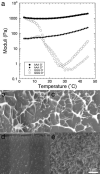Rational design and application of responsive alpha-helical peptide hydrogels
- PMID: 19543314
- PMCID: PMC2869032
- DOI: 10.1038/nmat2479
Rational design and application of responsive alpha-helical peptide hydrogels
Abstract
Biocompatible hydrogels have a wide variety of potential applications in biotechnology and medicine, such as the controlled delivery and release of cells, cosmetics and drugs, and as supports for cell growth and tissue engineering. Rational peptide design and engineering are emerging as promising new routes to such functional biomaterials. Here, we present the first examples of rationally designed and fully characterized self-assembling hydrogels based on standard linear peptides with purely alpha-helical structures, which we call hydrogelating self-assembling fibres (hSAFs). These form spanning networks of alpha-helical fibrils that interact to give self-supporting physical hydrogels of >99% water content. The peptide sequences can be engineered to alter the underlying mechanism of gelation and, consequently, the hydrogel properties. Interestingly, for example, those with hydrogen-bonded networks of fibrils melt on heating, whereas those formed through hydrophobic fibril-fibril interactions strengthen when warmed. The hSAFs are dual-peptide systems that gel only on mixing, which gives tight control over assembly. These properties raise possibilities for using the hSAFs as substrates in cell culture. We have tested this in comparison with the widely used Matrigel substrate, and demonstrate that, like Matrigel, hSAFs support both growth and differentiation of rat adrenal pheochromocytoma cells for sustained periods in culture.
Figures




Similar articles
-
Assessing cellular response to functionalized α-helical peptide hydrogels.Adv Healthc Mater. 2014 Sep;3(9):1387-91. doi: 10.1002/adhm.201400065. Epub 2014 Mar 24. Adv Healthc Mater. 2014. PMID: 24659615 Free PMC article.
-
Stimuli-Responsive, Pentapeptide, Nanofiber Hydrogel for Tissue Engineering.J Am Chem Soc. 2019 Mar 27;141(12):4886-4899. doi: 10.1021/jacs.8b13363. Epub 2019 Mar 12. J Am Chem Soc. 2019. PMID: 30830776
-
Self-assembling peptide nanofiber hydrogels in tissue engineering and regenerative medicine: Progress, design guidelines, and applications.J Biomed Mater Res A. 2016 Apr;104(4):1002-16. doi: 10.1002/jbm.a.35638. Epub 2016 Jan 25. J Biomed Mater Res A. 2016. PMID: 26707893 Review.
-
Hierarchically structured hydrogels utilizing multifunctional assembling peptides for 3D cell culture.Biomater Sci. 2020 Mar 7;8(5):1256-1269. doi: 10.1039/c9bm01894h. Epub 2019 Dec 19. Biomater Sci. 2020. PMID: 31854388 Free PMC article.
-
Biomaterials via peptide assembly: Design, characterization, and application in tissue engineering.Acta Biomater. 2022 Mar 1;140:43-75. doi: 10.1016/j.actbio.2021.10.030. Epub 2021 Oct 25. Acta Biomater. 2022. PMID: 34710626 Free PMC article. Review.
Cited by
-
Peptide:glycosaminoglycan hybrid hydrogels as an injectable intervention for spinal disc degeneration.J Mater Chem B. 2016 May 11;4(19):3225-3231. doi: 10.1039/c6tb00121a. Epub 2016 May 21. J Mater Chem B. 2016. PMID: 27429755 Free PMC article.
-
A New Hope: Self-Assembling Peptides with Antimicrobial Activity.Pharmaceutics. 2019 Apr 4;11(4):166. doi: 10.3390/pharmaceutics11040166. Pharmaceutics. 2019. PMID: 30987353 Free PMC article. Review.
-
Supramolecular hydrogels made of basic biological building blocks.Chem Asian J. 2014 Jun;9(6):1446-72. doi: 10.1002/asia.201301693. Epub 2014 Mar 12. Chem Asian J. 2014. PMID: 24623474 Free PMC article. Review.
-
Promoting collagen synthesis: a viable strategy to combat skin ageing.J Enzyme Inhib Med Chem. 2025 Dec;40(1):2488821. doi: 10.1080/14756366.2025.2488821. Epub 2025 Apr 11. J Enzyme Inhib Med Chem. 2025. PMID: 40213810 Free PMC article. Review.
-
Genetically Fusing Order-Promoting and Thermoresponsive Building Blocks to Design Hybrid Biomaterials.Chemistry. 2024 May 28;30(30):e202400582. doi: 10.1002/chem.202400582. Epub 2024 Apr 10. Chemistry. 2024. PMID: 38501912 Free PMC article. Review.
References
-
- Hirst AR, Escuder B, Miravet JF, Smith DK. High-Tech Applications of Self-Assembling Supramolecular Nanostructured Gel-Phase Materials: From Regenerative Medicine to Electronic Devices. Angew. Chem.-Int. Edit. 2008;47:8002–8018. - PubMed
-
- Woolfson DN, Ryadnov MG. Peptide-based fibrous biomaterials: some things old, new and borrowed. Curr. Opin. Chem. Biol. 2006;10:559–567. - PubMed
-
- Ulijn RV, Smith AM. Designing peptide based nanomaterials. Chem. Soc. Rev. 2008;37:664–675. - PubMed
-
- Hirst AR, Smith DK. Two-component gel-phase materials - Highly tunable self-assembling systems. Chem.-Eur. J. 2005;11:5496–5508. - PubMed
Publication types
MeSH terms
Substances
Grants and funding
LinkOut - more resources
Full Text Sources
Other Literature Sources
Miscellaneous

